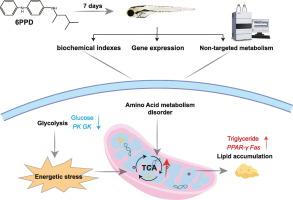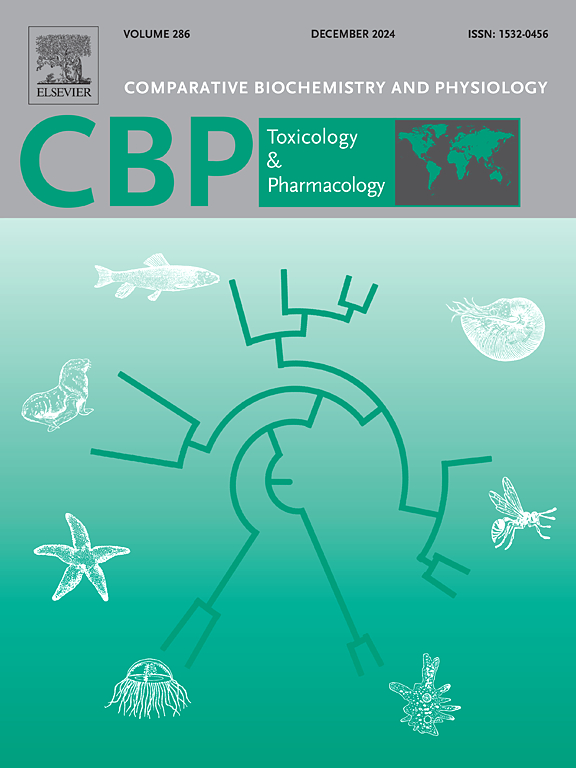Tire rubber-derived contaminant 6PPD had the potential to induce metabolism disorder in early developmental stage of zebrafish
IF 4.3
3区 环境科学与生态学
Q2 BIOCHEMISTRY & MOLECULAR BIOLOGY
Comparative Biochemistry and Physiology C-toxicology & Pharmacology
Pub Date : 2024-10-25
DOI:10.1016/j.cbpc.2024.110062
引用次数: 0
Abstract
The increasing release of tire-derived particles, particularly those containing N-(1,3-dimethylbutyl)-N′-phenyl-p-phenylenediamine (6PPD), into the environment has raised concerns regarding their ecological impact. This study aims to elucidate the toxicological effects of 6PPD on the metabolism in early developmental stage of zebrafish. Larval zebrafish were exposed to 10 and 100 μg/L 6PPD, and some endpoints in biochemical parameters, gene expression, and metabolism were analyzed. The results showed that 6PPD exposure disrupted glucolipid metabolism in zebrafish larvae, evidenced by increased triglyceride (TG) levels and decreased glucose content. Nile red staining indicated significant lipid accumulation in the liver and intestines. Additionally, RT-qPCR analysis revealed the upregulation of genes involved in lipid synthesis and metabolism, such as ppar-γ and fas, and downregulation of glycolysis-related genes like pk and gk. Furthermore, the untargeted metabolomics technique was used to identify a total of 220 differentially expressed metabolites (DEMs) with changes in amino acid metabolism, lipid metabolism, and the TCA cycle. KEGG pathway enrichment analysis highlighted disruptions mainly in Taurine and hypotaurine metabolism, Arginine and proline metabolism, and Histidine metabolism, which played very important roles on energy metabolism in zebrafish. The results provided some critical insights into the ecological risks associated with 6PPD.

源自轮胎橡胶的污染物 6PPD 有可能诱发斑马鱼早期发育阶段的代谢紊乱
越来越多的轮胎衍生颗粒,尤其是含有 N-(1,3-二甲基丁基)-N′-苯基-对苯二胺(6PPD)的轮胎衍生颗粒被释放到环境中,引起了人们对其生态影响的关注。本研究旨在阐明 6PPD 对斑马鱼早期发育阶段代谢的毒理影响。将幼体斑马鱼暴露于 10 和 100 μg/L 的 6PPD 中,分析其生化指标、基因表达和新陈代谢的一些终点。结果表明,暴露于 6PPD 会破坏斑马鱼幼体的糖脂代谢,表现为甘油三酯(TG)水平升高和葡萄糖含量降低。尼罗河红染色表明,肝脏和肠道中存在大量脂质积累。此外,RT-qPCR 分析显示,参与脂质合成和代谢的基因(如 ppar-γ 和 fas)上调,而糖酵解相关基因(如 pk 和 gk)下调。此外,利用非靶向代谢组学技术,共鉴定出 220 个差异表达代谢物(DEMs),这些代谢物涉及氨基酸代谢、脂质代谢和 TCA 循环。KEGG 通路富集分析显示,斑马鱼的能量代谢主要受牛磺酸和低牛磺酸代谢、精氨酸和脯氨酸代谢以及组氨酸代谢的干扰,而这些代谢对斑马鱼的能量代谢起着非常重要的作用。研究结果为了解与 6PPD 相关的生态风险提供了一些重要启示。
本文章由计算机程序翻译,如有差异,请以英文原文为准。
求助全文
约1分钟内获得全文
求助全文
来源期刊
CiteScore
7.50
自引率
5.10%
发文量
206
审稿时长
30 days
期刊介绍:
Part C: Toxicology and Pharmacology. This journal is concerned with chemical and drug action at different levels of organization, biotransformation of xenobiotics, mechanisms of toxicity, including reactive oxygen species and carcinogenesis, endocrine disruptors, natural products chemistry, and signal transduction with a molecular approach to these fields.

 求助内容:
求助内容: 应助结果提醒方式:
应助结果提醒方式:


